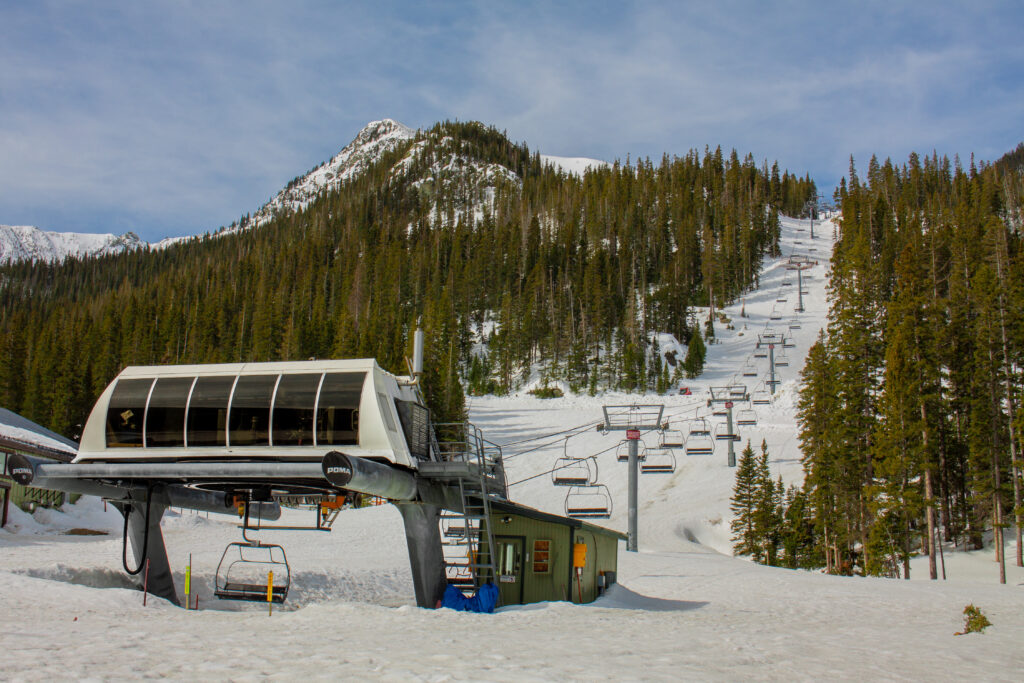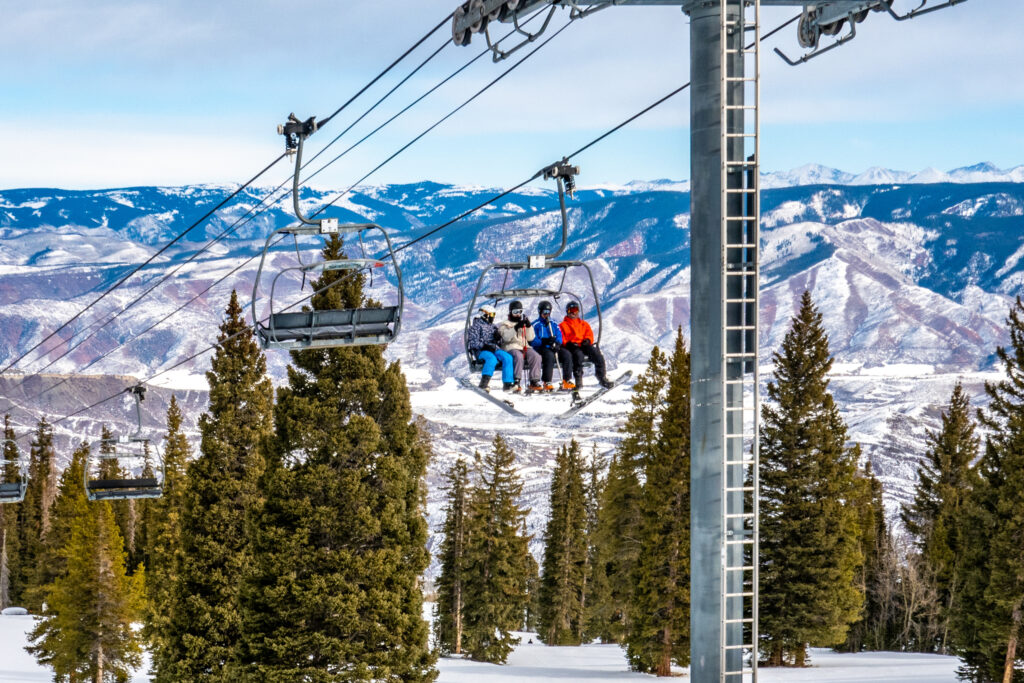Ski Sustainably At These Innovative U.S. Resorts

Our content may include affiliate links, through which we earn a small commission on purchases. Want to learn more about us? Read here.
In the heart of the mountains, where the thrill of skiing meets the tranquility of snow-covered landscapes, lies an industry at a crossroads. With its direct reliance on the natural environment, the ski industry faces a pivotal challenge: navigating the impacts of climate change while ensuring its sustainability.
This challenge underscores the importance of integrating sustainable practices into every facet of its operations. From preserving the delicate ecosystems that host these adventurous pursuits to mitigating the effects of climate change, the path forward for ski resorts is clear yet complex.
Sustainability in the ski industry transcends environmental stewardship—it’s about securing the economic future of resorts and the communities they support, all while setting a standard for responsible outdoor recreation. As climate patterns shift, bringing uncertainty to snowfall and season lengths, the industry’s move towards renewable energy sources, energy efficiency, and reduced carbon footprints is not just commendable but essential.
This blog post delves into U.S. ski resorts elevating sustainability and eco-friendly practices through innovation and their committed efforts, leading the charge toward a more sustainable, resilient, and environmentally conscious future. Join us as we explore how these winter havens are not just adapting to change but striving to be at the forefront of the global fight against climate change, setting a legacy far beyond the slopes.
Across the United States, a significant and encouraging trend is emerging within the ski industry as resorts increasingly adopt eco-friendly practices. This movement towards sustainability reflects a collective acknowledgment of the environmental responsibilities of operating in some of the country’s most pristine natural settings.
From Vail Resorts’ ambitious goal to achieve net-zero emissions by 2030 to the innovative waste reduction and renewable energy initiatives at Alta Ski Resort, the industry is taking proactive steps to minimize its carbon footprint and protect the ecosystems essential to its success.
These efforts, ranging from installing solar panels and wind turbines to comprehensive recycling programs and conservation projects, demonstrate a commitment to environmental stewardship and signal a shift towards a more sustainable future for outdoor recreation.
As more resorts join this green revolution, it’s clear that the ski industry is not just chasing snow but also leading the charge in the fight against climate change, setting a powerful example for businesses and individuals alike.
Disclaimer: While it can be argued that the very nature of large mountain resorts, attracting masses of visitors who often drive to these destinations, inherently carries a significant environmental impact, it’s essential to recognize that these resorts are a standing part of our recreational landscape.
Acknowledging their existence, many of these resorts have committed to conscientious practices aimed at minimizing their ecological footprint. While not erasing the impact, these efforts demonstrate a proactive approach to reducing the ecological effects and fostering a more sustainable future for the industry.
Leading US Resorts in Sustainability
Vail Resorts

Vail Resorts, a leader in the global ski industry, has set an ambitious environmental goal: achieving net-zero emissions across all its operations by 2030. This commitment is a cornerstone of their comprehensive “Epic Promise for a Zero Footprint,” which encompasses a wide range of sustainability initiatives designed to reduce the company’s impact on the environment significantly.
The goal addresses three main areas: emissions, waste, and forests. Specifically, for emissions, Vail Resorts aims to cut its carbon footprint to zero by investing in renewable energy projects, improving energy efficiency across its resorts, and purchasing renewable energy credits to offset its remaining emissions.
This bold move is part of a larger strategy to combat climate change and promote sustainable practices within the ski industry. By tackling the challenge head-on, Vail Resorts is setting a new standard for environmental responsibility and encouraging others in the industry to follow suit, demonstrating that significant, positive environmental impact is possible on a large scale.
The company reached a significant milestone by securing 100% renewable electricity for the second consecutive year across its 37 North American resorts, a feat underscored by investments in renewable electricity development, including large-scale wind farms and local renewable programs.
A pivotal component of Vail Resorts’ strategy involved the Plum Creek Wind project, a large-scale wind farm in Wayne County, Nebraska. This project alone addresses over 90% of Vail Resorts’ current electricity use across its North American resorts. It demonstrates the effectiveness of Virtual Power Purchase Agreements (VPPAs) as a mechanism for geographically diverse companies to contribute significantly to the renewable energy grid.
This effort was part of a broader commitment that saw Vail Resorts participating in Xcel Energy’s Renewable Connect program and advocating for Rocky Mountain Power’s renewable energy project to increase green energy in Utah.
Additionally, Vail Resorts has committed $25 million towards energy-saving projects focused on snowmaking efficiency, LED lighting retrofits, and facility system upgrades, aiming for a 15% energy efficiency saving from its 2017 baseline. This comprehensive approach aligns with their ambitious environmental targets and showcases a model for the ski industry’s transition towards sustainable and responsible energy use.
Alta Ski Resort, Utah

Alta Ski Resort in Utah was awarded the NSAA (National Ski Areas Association) Golden Eagle Award for Overall Environmental Excellence in 2022, a testament to its commitment to sustainability and environmental stewardship. This recognition resulted from several impactful initiatives led by the Alta Environmental Center (AEC).
Key to their success was the resort’s investment in renewable energy credits (RECs) to offset 100% of its electricity use with renewable energy, signaling a significant step towards reducing its carbon footprint.
Additionally, Alta’s innovative food waste diversion program, in partnership with Snowbird, showcased its dedication to sustainability by diverting 41,000 pounds of food waste from landfills into a digester to create biomethane, a renewable natural gas.
Beyond these programs, Alta’s long-term commitment to land conservation and environmental restoration has been pivotal. In collaboration with the US Forest Service, the resort has embarked on extensive revegetation projects, tree planting, and invasive plant species removal to heal and restore the land affected by past mining activities.
Since 1991, these efforts have resulted in planting over 42,000 trees and 79,000 plants, revitalizing the mountain environment and preserving its natural beauty for future generations.
Alta’s sustainability efforts are deeply integrated into its organizational culture, with a guiding principle shared with employees that emphasizes respect and value for the environment, commitment to protection and improvement in economically viable ways, and the benefit of both the company and community.
This holistic approach to sustainability, combining renewable energy, waste management, and land conservation, underscores Alta’s leading role in environmental stewardship within the ski industry.
For more detailed information on Alta Ski Resort’s sustainability initiatives and the Alta Environmental Center, you can visit their official site and the detailed article on Snow Industry News.
Park City and Deer Valley, Utah

Park City and Deer Valley in Utah are at the forefront of adopting solar energy to meet 100% of their energy needs through several innovative initiatives. A significant step towards this goal is constructing an 80-megawatt solar farm in Tooele County, set to power the operations of Park City, Summit County, Park City Mountain Resort, and Deer Valley Resort, among others.
This solar farm project will provide 100% renewable energy to these entities. It represents a pivotal move towards sustainability, aiming to cover municipal operations and potentially extending to residential customers soon.
The project aligns with Park City’s broader climate goals, including achieving net-zero carbon emissions and running entirely on renewable electricity by 2030 for the entire community.
Moreover, Park City has demonstrated a proactive approach to tackling climate change and promoting environmental sustainability. Park City’s efforts include reducing greenhouse gas emissions, increasing the use of renewable energy, and implementing energy conservation measures.
Through strategic collaborations and legislative efforts, such as the Community Renewable Energy Act of 2019, Park City has facilitated the legal pathway for communities aspiring to transition to 100% renewable electricity.
Park City and Deer Valley initiatives are about transitioning to renewable energy sources and setting a precedent for climate action in the ski industry and communities across North America. Their commitment reflects a broader vision of sustainability and environmental stewardship, aiming to preserve Utah’s mountainous regions’ natural beauty and winter sports conditions for future generations.

Deer Valley Resort has been proactive in its commitment to sustainability, participating in environmental efforts that reduce its carbon footprint. This includes significant land conservation efforts and initiatives to improve operational sustainability. Deer Valley, Park City Mountain, and the town have been working closely to align their sustainability practices, demonstrating a collaborative approach to environmental stewardship.
Powder Mountain, Utah

Powder Mountain in Utah is strongly committed to minimizing its environmental impact, focusing on sustainable practices that preserve the natural beauty of its surroundings while providing a high-quality experience for its visitors. This commitment concerns several key initiatives to reduce the resort’s carbon footprint and promote conservation.
Firstly, Powder Mountain prioritizes land conservation, ensuring that a significant portion remains undeveloped and natural. The resort protects local ecosystems and wildlife habitats by maintaining vast areas as open spaces, contributing to biodiversity preservation.
Secondly, the resort has taken steps to reduce waste and energy consumption. Initiatives such as eliminating single-use plastic bottles from its operations and employing energy-efficient practices across its facilities help decrease its environmental impact. These actions reduce waste and energy use and set a standard for responsible resource management in the ski industry.
Moreover, Powder Mountain focuses on using natural snow as much as possible, minimizing the need for artificial snowmaking, which can be water and energy-intensive. This approach conserves resources and enhances the quality of the skiing experience by providing visitors with the natural snow conditions that Utah is famous for.
In addition to these efforts, Powder Mountain has engaged in reforestation projects, planting thousands of trees to help offset carbon emissions and restore natural areas impacted by development or natural events. This reforestation work not only helps combat climate change but also improves the health and resilience of local forests.
Overall, Powder Mountain’s commitment to minimal environmental impact reflects a comprehensive approach to sustainability, combining conservation efforts, resource efficiency, and community engagement to protect and enhance the natural environment for future generations.
Powder Mountain in Utah actively engages in several environmental initiatives focused on land conservation, plastic reduction, and reforestation efforts, demonstrating a comprehensive approach to sustainability within the ski and outdoor recreation industry.
Land Conservation
Powder Mountain has committed significantly to preserving the natural environment by maintaining a large portion of its land as open space. This commitment ensures that most of the area remains undeveloped and natural, protecting ecosystems and wildlife habitats from the adverse effects of extensive development. By prioritizing land conservation, Powder Mountain contributes to biodiversity preservation and maintains the region’s natural beauty for visitors and future generations.
Plastic Reduction
Powder Mountain has implemented initiatives to reduce the use of single-use plastics within its operations to reduce waste and minimize its environmental footprint. This includes eliminating plastic bottles and encouraging reusable materials among guests and staff. Such measures reduce the amount of waste the resort generates and raise awareness about the importance of waste reduction and responsible consumption practices among the community.
Reforestation Efforts
Powder Mountain is also involved in reforestation projects, which play a crucial role in offsetting carbon emissions and restoring natural habitats. These efforts involve planting trees in areas affected by development or natural disturbances, helping to rebuild forested areas, enhancing carbon sequestration, and improving soil health and water quality. Reforestation contributes to the global fight against climate change and enhances the resort’s landscape’s ecological integrity and aesthetic value.
Together, these actions reflect Powder Mountain’s commitment to environmental stewardship and its dedication to preserving the natural resources that make the region unique. By focusing on land conservation, plastic reduction, and reforestation, Powder Mountain sets a positive example for the outdoor recreation industry and contributes to the broader goal of sustainable development.
Jiminy Peak, Massachusetts

Jiminy Peak Mountain Resort in Massachusetts has distinguished itself as an early adopter of wind energy within the ski industry, underscoring its commitment to sustainability and environmental stewardship. The resort’s landmark initiative, installing a wind turbine known as Zephyr, represents a significant step forward in reducing its carbon footprint and promoting renewable energy sources.
The Zephyr Wind Turbine
Zephyr, a 1.5-megawatt wind turbine, was installed at the resort in 2007. Standing at 253 feet tall, with blades that stretch 123 feet in length, the turbine is positioned at the summit of Jiminy Peak, where it can capture the strong winds that blow across the Berkshires. This strategic placement allows Zephyr to operate efficiently, harnessing wind power to generate electricity.
Impact on the Resort’s Energy Consumption
Zephyr generates approximately 4.6 million kilowatt-hours of electricity annually, accounting for about two-thirds of Jiminy Peak’s total energy needs. This substantial contribution significantly reduces the resort’s reliance on fossil fuels and diminishes its overall environmental impact. By integrating wind power into its energy mix, Jiminy Peak has effectively reduced its carbon emissions and set a precedent for renewable energy use in the ski industry.
Sustainability and Education
Beyond the environmental benefits, the wind turbine is an educational tool for visitors and the local community. Jiminy Peak uses Zephyr to raise awareness about renewable energy and climate change, offering informational displays that explain how the turbine works and its role in the resort’s sustainability efforts. This educational aspect amplifies the turbine’s impact, inspiring others to consider renewable energy solutions.
A Model for the Ski Industry
Jiminy Peak’s investment in wind energy has positioned the resort as a leader in sustainability within the ski industry. The success of Zephyr has demonstrated the viability of renewable energy projects for major ski resorts, encouraging others to explore similar initiatives. As a pioneer in this area, Jiminy Peak has shown that environmental responsibility can go hand in hand with providing a high-quality recreational experience.
Jiminy Peak’s early adoption of wind energy through the Zephyr wind turbine exemplifies the resort’s innovative approach to sustainability. By prioritizing renewable energy, Jiminy Peak reduces its environmental impact and contributes to the broader movement towards cleaner, more sustainable energy sources.
Jiminy Peak Mountain Resort in Massachusetts has made a significant stride in reducing its electrical demands through the installation of a wind turbine named Zephyr. This pioneering initiative has positioned the resort as a leader in sustainable energy use within the ski industry. The Zephyr wind turbine, a 1.5-megawatt installation, is a testament to the resort’s commitment to environmental stewardship and proactive approach to reducing its carbon footprint.
The turbine, installed at the summit of the resort, capitalizes on the strong winds prevalent in the area, generating approximately 4.6 million kilowatt-hours of electricity annually. This production meets about two-thirds of Jiminy Peak’s total electricity needs, substantially reducing the resort’s reliance on traditional, non-renewable energy sources. The transition to wind power has allowed Jiminy Peak to significantly decrease its electrical demands from the grid significantly, thereby reducing its overall environmental impact.
The success of the Zephyr turbine in cutting down Jiminy Peak’s electrical demands showcases the potential of renewable energy sources in large-scale operations such as a ski area. This initiative serves as a model for energy efficiency and sustainability in the ski industry and demonstrates the viability and benefits of investing in renewable energy technologies. Through Zephyr, Jiminy Peak has effectively lowered its operational costs, reduced carbon emissions, and set a precedent for integrating sustainable practices into the ski resort business model.
Wild Mountain, Minnesota

Wild Mountain, a ski resort in Minnesota, achieved Carbon Neutral certification by actively engaging in comprehensive efforts to calculate, reduce, and offset its carbon emissions. This initiative reflects the resort’s commitment to environmental sustainability and its proactive approach to climate change. Although the specific date of the certification is not detailed here, the process typically involves several key steps that align with recognized standards for carbon neutrality.
The resort first conducted a thorough inventory of its greenhouse gas emissions to understand its carbon footprint. This assessment likely included emissions from all sources associated with the resort’s operations, such as energy consumption, transportation, and waste management. Following the inventory, Wild Mountain would have implemented measures to reduce its emissions, focusing on energy efficiency, renewable energy sources, waste reduction, and other sustainable practices.
Wild Mountain compensated for its unavoidable emissions by purchasing carbon offsets to achieve Carbon Neutral certification. Carbon offsets are credits for emission reductions achieved elsewhere, such as reforestation projects, renewable energy installations, or other programs that reduce or capture atmospheric carbon dioxide. Wild Mountain balanced out its carbon footprint by investing in offsets equivalent to its residual emissions, thereby achieving carbon neutrality.
The certification process involves verification by a third-party organization that ensures the resort’s emissions calculations, reduction efforts, and offsets meet established standards for carbon neutrality. This external validation confirms the integrity and impact of Wild Mountain’s sustainability efforts.
Achieving carbon-neutral certification signifies Wild Mountain’s dedication to sustainability and its role as a leader in the ski industry’s transition toward more environmentally responsible practices. It showcases the resort’s efforts to mitigate its impact on climate change and contribute to global sustainability goals.
Wild Mountain in Minnesota has taken significant steps to eliminate single-use plastics and implement eco-friendly operations as part of its commitment to environmental sustainability. These initiatives reflect a broader effort within the outdoor recreation industry to reduce environmental impacts and promote sustainable practices.
Elimination of Single-Use Plastics
Wild Mountain has actively worked to reduce its reliance on single-use plastics, which are known to contribute significantly to pollution and environmental degradation. This effort likely includes replacing single-use plastic items, such as straws, cutlery, and food packaging, with alternatives made from biodegradable, compostable, or reusable materials. By doing so, Wild Mountain reduces the amount of plastic waste generated at the resort, minimizes its environmental footprint, and promotes more sustainable consumption patterns among its visitors.
Eco-Friendly Operations
In addition to addressing the issue of single-use plastics, Wild Mountain has embraced a range of eco-friendly operational practices designed to conserve resources, reduce waste, and minimize carbon emissions. These practices could encompass various aspects of the resort’s operations, including energy use, waste management, water conservation, and transportation.
Energy Efficiency: Implementing energy-saving measures such as LED lighting, efficient heating and cooling systems, and potentially harnessing renewable energy sources to power the resort’s facilities.
Waste Reduction and Recycling: Establishing comprehensive waste management programs prioritizing recycling and composting, diverting waste from landfills, and reducing the overall waste generated by resort operations.
Water Conservation: Utilizing water-saving technologies and practices to minimize water usage in snowmaking, landscaping, and facility operations.
Sustainable Transportation: Encouraging public transportation, carpooling, and electric vehicles among guests and staff to reduce the carbon footprint associated with travel to and from the resort.
By eliminating single-use plastics and adopting eco-friendly operational practices, Wild Mountain demonstrates its dedication to sustainability and its responsibility as a steward of the natural environment. These efforts contribute to the health and preservation of the local ecosystem and set a positive example for guests and the wider community, highlighting the importance of environmental consciousness in the context of outdoor recreation.
Stratton Mountain, Vermont

Stratton Mountain in Vermont has become a leader in solar energy production within the ski industry through strategic investments, partnerships, and a strong commitment to renewable energy. This leadership is part of a broader sustainability strategy to reduce the resort’s carbon footprint and promote environmental stewardship. Here’s how Stratton Mountain achieved its status as a leader in solar energy production:
Investment in Solar Projects
Stratton Mountain has actively invested in solar energy projects by directly installing solar panels on its property or participating in local or regional solar initiatives. These investments have enabled the resort to generate a significant portion of its energy needs from solar power, reducing reliance on traditional, non-renewable energy sources.
Collaboration with Energy Providers and Local Governments: Collaborating with energy providers, local governments, and environmental organizations has been crucial for Stratton Mountain to access the resources and support needed for large-scale solar projects. These partnerships have facilitated the planning, financing, and implementation of solar installations and have often included incentives for renewable energy investment.
Utilization of State and Federal Incentives
Using state and federal incentives for renewable energy projects has allowed Stratton Mountain to offset the costs associated with solar installations. Tax credits, grants, and renewable energy certificates (RECs) are among the incentives that have made solar projects more financially viable for the resort.
Commitment to Sustainability Goals: Stratton Mountain’s leadership in solar energy production is rooted in its broader commitment to sustainability and environmental responsibility. By setting ambitious goals for renewable energy use and carbon neutrality, the resort has prioritized investments in solar power as a key strategy for achieving these objectives.
Educating and Engaging the Community
Part of Stratton Mountain’s success in solar energy production has involved educating and engaging guests, staff, and the local community about the benefits of renewable energy. Through outreach and informational campaigns, the resort has raised awareness about its solar initiatives, fostering a culture of sustainability among its stakeholders.
Continuous Improvement and Expansion
Stratton Mountain continues exploring opportunities to expand its solar energy production, including adding more solar panels and participating in new renewable energy projects. This commitment to continuous improvement ensures that the resort remains at the forefront of renewable energy use in the ski industry.
By leveraging these strategies, Stratton Mountain has reduced its environmental impact and positioned itself as a leader in solar energy production. This leadership reflects a growing trend in the ski industry towards sustainability and renewable energy, with Stratton Mountain setting a positive example for other resorts.
By purchasing Renewable Energy Credits (RECs), Stratton Mountain has been able to offset its carbon emissions further and support the development of renewable energy infrastructure beyond its immediate operations.
Stratton Mountain has also been involved in advocacy efforts for environmental policies that support renewable energy and climate action. By lending its voice to the broader conversation on sustainability, the resort has contributed to policy changes that facilitate the transition to a cleaner, more sustainable energy future.
Through these comprehensive steps, Stratton Mountain has significantly reduced its reliance on fossil fuels and moved towards a more sustainable, carbon-free energy model. The resort’s success in achieving 94% carbon-free energy usage serves as an inspiring example for the ski industry and other businesses looking to reduce their environmental impact.
Sunlight Mountain Resort, Colorado

Sunlight Mountain Resort in Colorado actively embraces sustainability through initiatives focused on electric vehicle (EV) incentives and solar-powered operations, demonstrating a strong commitment to environmental stewardship and renewable energy.
Electric Vehicle Incentives:
Sunlight Mountain Resort has implemented measures to encourage electric vehicles among its guests and staff, recognizing the significant environmental benefits of EVs in reducing greenhouse gas emissions and dependence on fossil fuels. One notable initiative is the installation of electric vehicle charging stations at the resort.
These charging stations provide convenient access for EV drivers to recharge their vehicles, promoting cleaner transportation options. Sunlight Mountain Resort has also offered promotions and incentives for EV drivers, such as discounted or complimentary services, to encourage the shift towards electric mobility further. These incentives support EV users and align with broader efforts to reduce the carbon footprint associated with transportation to and from the resort.
Solar-Powered Operations:
In its pursuit of renewable energy solutions, Sunlight Mountain Resort has invested in solar power to meet its operational energy needs. This includes the installation of solar panels on-site, which generate clean, renewable energy for the resort’s facilities.
The resort reduces its reliance on conventional energy sources and decreases its environmental impact by harnessing solar power. The resort’s solar-powered operations contribute to its sustainability goals, lowering energy costs and supporting the transition to a more sustainable energy future.
Furthermore, the resort’s commitment to solar power extends beyond its immediate operations. The resort actively participates in local and regional solar initiatives, collaborating with energy providers, government agencies, and environmental organizations to support the development of solar energy infrastructure in the community and beyond.
Sunlight Mountain Resort is taking concrete steps toward sustainability by offering electric vehicle incentives and implementing solar-powered operations. These initiatives enhance the resort’s environmental performance and set a positive example for the ski industry and the wider community, highlighting the feasibility and benefits of adopting renewable energy and promoting sustainable transportation solutions.
Sunlight Mountain Resort in Colorado is taking proactive steps to promote the use of natural snow and enhance its recycling programs as part of its broader commitment to environmental sustainability and stewardship. These initiatives reflect the resort’s dedication to preserving natural resources and reducing its ecological footprint.
Promotion of Natural Snow:
Sunlight Mountain Resort leverages its geographical location and climate conditions to maximize the use of natural snow for skiing and snowboarding. By promoting natural snow, the resort reduces the need for artificial snowmaking, which can be energy and water-intensive. This approach conserves resources and provides guests with a more authentic and environmentally friendly skiing experience.
Sunlight Mountain may employ strategic grooming practices that preserve snow quality and extend its usability throughout the season to ensure the best use of natural snow. Additionally, the resort’s efforts to maintain and enhance its natural snow capabilities are aligned with its sustainability goals, emphasizing the importance of working with, rather than against, the natural environment.
Recycling Programs:
Sunlight Mountain Resort has implemented comprehensive recycling programs to manage the waste its operations and visitors generate. These programs aim to reduce the amount of waste sent to landfills by recycling materials such as paper, cardboard, plastics, metals, and glass. By providing clearly marked recycling bins throughout the resort and encouraging guests and staff to participate in recycling efforts, Sunlight Mountain fosters a culture of environmental responsibility.
The resort’s recycling programs are part of a broader waste management strategy that may also include composting organic waste and reducing single-use plastics. Through education and engagement, Sunlight Mountain Resort raises awareness about the importance of recycling and waste reduction, contributing to conservation efforts and promoting sustainable practices within the community.
Promoting natural snow and implementing robust recycling programs demonstrate Sunlight Mountain Resort’s commitment to sustainability. These initiatives not only enhance the environmental performance of the resort but also set a positive example for the outdoor recreation industry, showcasing practical measures to protect and preserve natural resources for future generations.
Notable Mentions
Sundance Mountain Resort

Sundance Mountain Resort, founded by Robert Redford on environmental stewardship and conservation principles, stands as a beacon of sustainability within the hospitality and ski industry. Embracing its commitment to the environment, the resort invests in renewable energy credits (RECs) to offset its energy use, supporting the growth of clean, renewable energy projects.
Alongside this, Sundance has implemented unique recycling programs that go beyond conventional materials, aiming to reduce waste and promote a culture of sustainability among its guests and staff. These initiatives reflect Sundance Mountain Resort’s deep-rooted dedication to preserving its surroundings’ natural beauty and pioneering spirit in environmental conservation.
Taos Ski Valley, New Mexico

Taos Ski Valley in New Mexico has distinguished itself within the ski industry through its commitment to sustainability and environmental responsibility, evidenced by its achievement of B Corp certification. This prestigious designation acknowledges the resort’s dedication to meeting rigorous social and environmental performance standards, accountability, and transparency, setting it apart as a leader in sustainable business practices.
Further enhancing its eco-friendly credentials, Taos Ski Valley boasts a LEED-certified hotel, which exemplifies the resort’s commitment to green building principles, energy efficiency, and reduced carbon footprint. Additionally, Taos has implemented innovative recycling programs beyond traditional materials, focusing on minimizing waste and promoting a circular economy.
These initiatives demonstrate Taos Ski Valley’s proactive approach to environmental stewardship and reflect its role as a pioneer in integrating sustainability into every aspect of its operations.
Palisades Tahoe, California

Palisades Tahoe, formerly known as Squaw Valley Alpine Meadows in California, stands at the forefront of environmental sustainability in the ski industry, having committed to powering its operations with 100% renewable energy. This ambitious move aligns with the resort’s broader strategy to combat climate change and reduce its carbon footprint, underscoring a deep commitment to preserving the natural environment.
Beyond its transition to renewable energy, Palisades Tahoe has implemented various environmental conservation measures to protect local ecosystems and promote biodiversity. These initiatives range from water conservation efforts and habitat restoration projects to sustainable land management practices designed to minimize environmental impact.
The resort’s commitment to renewable energy and comprehensive conservation measures exemplify its role as a leader in environmental stewardship, setting a benchmark for sustainability within the ski industry and beyond.
Grand Targhee Resort, Wyoming

Grand Targhee Resort in Wyoming has embraced sustainability through targeted initiatives reflecting its commitment to environmental stewardship. The resort has undertaken a widespread installation of LED fixtures across its facilities, significantly reducing energy consumption and lowering its carbon footprint.
This transition to LED lighting is part of a broader commitment to eco-friendly practices within the lodge, including environmentally safe cleaning products, water conservation measures, and efforts to minimize waste.
In addition to these sustainable operational practices, Grand Targhee Resort has ramped up its recycling efforts, implementing comprehensive recycling programs that extend beyond traditional materials to include food waste composting and repurposing used cooking oil.
These concerted actions—from energy-efficient lighting and green lodge practices to expansive recycling—demonstrate Grand Targhee Resort’s dedication to reducing its environmental impact and promoting sustainability in every aspect of its operations.
Special Spotlight:
Aspen Snowmass

Aspen Snowmass has established itself as a pioneer in the ski industry through its comprehensive approach to sustainability. It was among the first major ski resort to engage in sustainability reporting, openly documenting its environmental impacts and progress towards reducing them. This transparency has set a benchmark for the industry, encouraging other companies to follow suit.
Aspen has also proactively implemented renewable energy projects, investing in solar arrays and supporting wind power to meet its energy needs with cleaner alternatives. Beyond its operational commitments, Aspen Snowmass has taken a leadership role in advocating for climate policy change, actively lobbying for legislation that addresses climate change and supports renewable energy development.
These efforts reflect Aspen’s holistic approach to sustainability, combining on-the-ground initiatives with broader advocacy to drive environmental progress within and beyond the ski industry.
Conclusion
Many of the above resorts have made significant sustainability and environmental stewardship strides. These resorts have implemented initiatives ranging from shuttle services, LED lighting, composting, B Corp certification, LEED-certified buildings, and renewable energy projects to extensive recycling programs.
Each resort’s efforts, whether through promoting natural snow, reducing single-use plastics, installing electric vehicle charging stations, or advocating climate policy change, demonstrate a strong commitment to reducing environmental impacts and promoting sustainable operations within the ski industry.
Supporting sustainability initiatives at ski resorts is essential for many interconnected reasons beyond the slopes. Firstly, it plays a crucial role in safeguarding our natural landscapes, ensuring these breathtaking environments remain untouched and vibrant for future generations. This consumer choice directly contributes to mitigating the effects of climate change by backing resorts that invest in renewable energy and adopt practices aimed at reducing carbon footprints.
Moreover, by favoring eco-friendly resorts, consumers drive economic incentives for the wider industry to embrace green practices, demonstrating a clear demand for sustainability in the market. Such support not only heightens awareness and educates the community about the importance of environmental stewardship but also spurs innovation within the industry, pushing resorts to discover new sustainable operation methods.
Beyond the environmental benefits, choosing sustainable resorts enhances the quality of the recreational experience, offering visitors pristine natural settings and more authentic interactions with the environment. Lastly, this support aligns with a broader sense of social responsibility, ensuring that the economic benefits of tourism are achieved without compromising environmental and social values.
Opting for sustainability in our recreational choices is a powerful statement of our collective responsibility towards the planet, promoting a healthier environment and a more sustainable future.
Actions We Skiers And Snowboarders Can Take:
Practice Responsible Travel
Opt for carpooling, public transportation, or electric vehicles when traveling to ski resorts. Reducing the carbon emissions associated with travel lessens your environmental footprint and contributes to cleaner air and reduced traffic congestion in mountain areas. Consider resorts closer to home to minimize long-distance travel and explore eco-friendly lodging options, emphasizing sustainability in their operations.
Support Eco-Friendly Resorts
Make informed decisions by choosing ski resorts committed to sustainability. Look for resorts that utilize renewable energy sources, engage in water conservation practices, offer recycling programs, and demonstrate a commitment to protecting local ecosystems. Your patronage of such resorts sends a strong message about consumer demand for sustainable practices within the industry.
Minimize Waste on the Slopes
Adopt a leave-no-trace ethos during your ski trips by minimizing waste and ensuring proper disposal. Bring reusable water bottles, coffee cups, and snack containers instead of single-use plastics. Participate in resort recycling programs and be mindful of your consumption patterns. Small actions, like picking up litter and respecting wildlife habitats, contribute significantly to preserving the natural beauty of ski areas.






